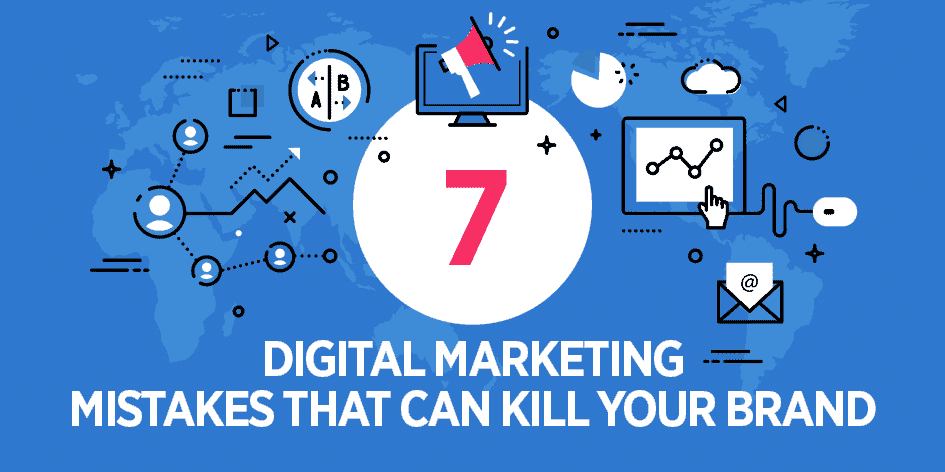Everyone makes mistakes.
You type “Helo” instead of “Hello” in one of your email newsletters.
You forget to create a custom URL for one of your blog posts.
You mistype an email subject line.
These are small things that, while certainly undesirable, probably won’t have a long-term negative effect on your brand (unless you do them habitually, of course, in which case you probably need to talk to us!).
But then there are the mega-mistakes. The things that can take a brand from being generally liked to generally loathed, or The snafus that are incredibly difficult to come back from.
Chances are, you’ve seen some or all of these screw-ups played out online in all their gut-churning glory. And goodness knows, you don’t want to be the next brand sacrificed at the altar of social media public opinion (which is even more cutthroat than public opinion IRL).
But mistakes don’t have to be public to be major. In fact, perhaps the worst mistakes you can make are the ones that get you…indifference. The digital marketing campaigns you shell out thousands, even hundreds of thousands, for, that get almost no results.
Without further ado, here’s a list of the mistakes that you really, really don’t want to make.
Hopping into a trending conversation online without having anything valuable to contribute.
We all know that authenticity is something consumers value almost above all else when it comes to marketing. This is especially true among Generation Z – according to a recent survey, 63 percent of Gen Z wants to see “real people” rather than celebrities in advertisements.
What this means is that the general consumer has a pretty sophisticated filter. They can sense when brands are engaging with conversations around a topic, movement, or current event as part of a sales pitch, rather than because it relates to their brand values.
For example, take the tragic passing of Prince in 2016. Along with the thousands of people who expressed their grief for the musician’s death on Twitter, countless brands tried to pay tribute, too. Some were appropriate and well-done – but others seemed to cross the line into self-promotion, like Cheerios’ attempt:
While the brand may not have meant for their tweet to feel like an advertisement, the social media universe definitely thought it did. The tweet was pulled down and an apology issued quickly.
A more fitting tribute was Instagrammed by the Minnesota Vikings:
Notice how there’s no mention of the brand anywhere on the image? That’s because this isn’t about the Vikings. It’s about Prince. That’s something you have to remember when deciding whether or not to comment on major events like this: it’s not really about your brand.
Shutting down a campaign or initiative prematurely because the results aren’t what you think they should be.
There’s a myth about digital marketing that just refuses to die: that digital marketing efforts create immediate results.
While this can be true in certain, one-off cases – like when we helped Dippin’ Dots write an open letter to Sean Spicer that went viral – the majority of the time, digital marketing takes time. It takes effort.
Let’s say you’re working on building a blog for your brand. You’ve been blogging regularly for the past 3 months, but you’re still not seeing a major increase in your site traffic. So you decide to put those blogging resources somewhere else.
What you should actually be doing, however, is looking more closely at your blog posts and site traffic to see what the posts are actually doing. Are they bringing in some traffic? Are certain posts getting more clicks than others?
Instead of blogging less frequently or not at all, you may need to change your blogging strategy or promote your blog posts better.
And, as difficult as it is, in some cases, you just need to keep building your momentum.
You don’t do your research.
The digital marketing world moves fast, for sure, but that doesn’t mean you should skip doing the research necessary for a post.
A perfect example is DC Comics, which posted an image of a comic they said was translated from … wait for it … Pakistanian. Yikes. We all know that’s not a language, right?
If you’re making any kind of factual claim, you’ve got to make sure your facts are correct before posting it for the entire internet-using world to see. Someone’s bound to screenshot your mistake before you delete it, and the results could be disastrous.
Buying fake followers.
Many brands are desperate for social media followers, and unsurprisingly, plenty of businesses have popped up with the aim of satisfying that need.
To do so, these companies employ a couple of techniques. Using your Twitter account, they might follow thousands of people each day, waiting for those accounts to follow you back. Then they unfollow the ones who don’t follow you back.
Another way is to use “zombie” accounts. These are inactive accounts created by the fake follower company that they use to artificially inflate the number of followers you have.
If you’re having trouble growing your social media following, maybe you’ve been tempted by these types of companies and their promises to get you thousands of followers quickly and painlessly. We get it.
But you don’t want mindless followers. You want engagement. Quantity might have beat out quality 10 years ago, but today, it’s all about quality. If you have 100 followers who engage with your social media posts, that’s much better than 100,000 followers who barely retweet you, let alone engage with your brand.
Plus, people can usually tell when your followers are fake, and the negative impact from having that knowledge floating around will be much worse than any potential negative from having just a few followers.
Not making the most of analytics.
Analytics are vitally important to the success of any digital marketing campaign. How else are you going to know what’s working and what isn’t? What’s worth the money you’re spending, and what’s simply a waste of resources?
What’s great about the analytics platforms out there today is that you can customize them so extensively that you’re able to discover all kinds of minute, yet crucial, details about your customers.
For example, you can use your analytics platform to see how your audience falls into various age ranges. If the majority of visitors fall into the 35-44 age range, you’ll want to focus on creating content that will appeal to this age group.
You can also use analytics to see how well a particular campaign is performing. If you’ve created a campaign-specific landing page, for example, you can see:
- How many visitors that page has received relative to other pages on your site
- What the bounce rate is
- How many unique visitors have visited that page
And much more.
Making poor use of humor.
Humor on the internet is a touchy thing.
There are so many examples of brands using humor that either falls flat or inadvertently comes off as offensive (IHOP’s “flat but has a great personality” pancake tweet, DiGiorno’s #WhyIStayed tweet) that it’s wise to think twice before trying to be funny or edgy on social media.
However, when used correctly, humor can be a powerful tool. Just look at Old Spice and their bizarre, yet hilarious social media voice:
We bet you remember the first time you saw their “The Man Your Man Could Smell Like” commercial, too. That was epic, right?
But you can bet that ad campaign wasn’t the product of a couple funny guys at Old Spice throwing around ideas. That was a finely honed, comprehensive brand campaign with a highly developed voice.
If your brand is willing to put in the time and effort to develop a specific humorous voice, and outline how it can be used, then you’ve probably got a good chance at doing funny well. But if all you’ve got is one funny person at the office who likes taking over the Twitter account now and then, well – it might be wise to leave the humor out of it.
Not focusing on your customer.
Whether you’re a B2C or B2B company, your digital marketing has to be all about your customer.
That means things like making it easy for customers to find your site or purchase products through your social media accounts, not bombarding them with constant marketing emails, and giving them a personalized experience.
But when it comes to social media, there are other ways to put the focus on your customer. For example, if a commenter on one of your social media posts is attacked or threatened by other commenters, it’s vital that you manage that situation and protect your customer by addressing those offensive comments head-on.
In most cases, it’s best to delete the threatening or offensive comments and make a statement about why you’ve deleted them. Care should be exercised, of course, but cruel language should never be tolerated.
Not planning.
Flexibility is important for a successful digital marketing campaign, but so too is planning. Before you launch a digital marketing campaign, which could take up huge amounts of resources, you should have a few things mapped out.
First, you’ve got to know what your objective is. Is it to gain more followers? To increase brand awareness? To sell more of Product A, B, or C?
You should also know what channels you’re focusing on and how you’ll be distributing the content associated with the campaign.
Will you be posting daily pictures on Instagram, and sharing them via your other social media accounts?
Will you be crowdsourcing images by asking fans to submit their own, with a particular hashtag?
Then, you’ve got to know how you’ll measure success. Will it be a percentage increase in unique site visitors? Lower bounce rates? An increase in conversion rate for email newsletter sign-ups?
Navigating the waters of digital marketing can be challenging. It’s important to be aware of the potential pitfalls so you can avoid them, and keep your brand from either fading away or going up in flames.





